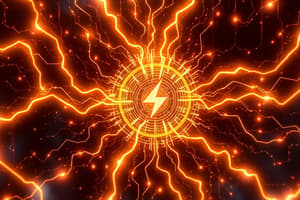Podcast
Questions and Answers
What unit is used to measure the amount of current in a circuit?
What unit is used to measure the amount of current in a circuit?
- Amps (correct)
- Volts
- Ohms
- Joules
How does an increase in temperature affect the drift velocity of electrons in a conductor?
How does an increase in temperature affect the drift velocity of electrons in a conductor?
- Decreases drift velocity (correct)
- Causes electrons to stop moving
- Has no effect on drift velocity
- Increases drift velocity
What factor influences the drift velocity of electrons in a conductor by causing them to accelerate more quickly?
What factor influences the drift velocity of electrons in a conductor by causing them to accelerate more quickly?
- Conductivity
- Kinetic energy
- Temperature
- Electric field strength (correct)
How is current flow speed typically measured in a circuit?
How is current flow speed typically measured in a circuit?
Why do electrons accelerate and decelerate within a circuit?
Why do electrons accelerate and decelerate within a circuit?
In the relationship between current and drift velocity, what does the symbol 'n' represent?
In the relationship between current and drift velocity, what does the symbol 'n' represent?
What role does the electric field play in influencing the movement of electrons in a circuit?
What role does the electric field play in influencing the movement of electrons in a circuit?
How does increasing the number of free electrons affect the current in a circuit?
How does increasing the number of free electrons affect the current in a circuit?
What is the main reason for the relatively slow speed of electron movement in a conductor?
What is the main reason for the relatively slow speed of electron movement in a conductor?
Compared to the speed of light, how fast is the drift velocity of electrons in a typical metal conductor?
Compared to the speed of light, how fast is the drift velocity of electrons in a typical metal conductor?
Which factor leads to higher drift velocities in conductive materials?
Which factor leads to higher drift velocities in conductive materials?
In the context of current flow speed, what does 'drift velocity' refer to?
In the context of current flow speed, what does 'drift velocity' refer to?
Flashcards are hidden until you start studying
Study Notes
Electrons in a Circuit: Exploring Current Flow Speed
In the realm of electrical circuits, we're concerned with the flow of electrons as they carry electric current. To better understand how electrons move in a circuit, let's delve into the topic of current flow speed.
Current Flow
Current is the rate of flow of electric charge through a circuit—specifically, the movement of electrons. Think of a current as a river of electrons. The amount of current in a circuit is measured in amperes (A), which represents the flow of one coulomb of charge per second.
Speed of Electrons
While the speed of electrons in a circuit may seem like a straightforward topic, it's not as simple as it appears. Electrons don't move at a uniform or constant speed within a circuit; instead, they accelerate and decelerate as they collide with atoms in the conductor's lattice structure.
A more accurate description of electron movement in a circuit involves discussing their drift velocity. Drift velocity refers to the average velocity of the electrons as they move through a conductor under the influence of an electric field. It's a statistical measure of the velocity of electrons in a conductor, where electrons continuously collide with atoms.
In a typical metal conductor, the drift velocity of electrons is very low compared to the speed of light, often being on the order of 1 mm/s. This relatively slow speed is due to the myriad collisions electrons experience as they move through the lattice structure of a conductor.
Factors Affecting Drift Velocity
Drift velocity is influenced by several factors, including the material's conductivity, the electric field strength, and the temperature of the conductor.
- Conductivity: Conductive materials have a higher number of free electrons available to carry current. As a result, higher conductivity leads to higher drift velocities.
- Electric Field Strength: The strength of the electric field in a conductor influences the drift velocity. A more robust electric field will cause electrons to accelerate more quickly, leading to higher drift velocities.
- Temperature: As temperature increases, the kinetic energy of atoms in the conductor lattice also increases, leading to more frequent collisions between electrons and atoms. Higher collision rates result in lower drift velocities.
The Relationship Between Current and Drift Velocity
The current in a circuit is directly proportional to the drift velocity of the electrons and the number of free electrons available to carry the current. Mathematically, this relationship can be described as:
[ Current = n * q * drift \ velocity ]
where (n) is the density of free electrons and (q) is the charge carried by each electron (approximately (1.6 \times 10^{-19} \ C)). This relationship demonstrates that an increase in drift velocity or the number of free electrons will lead to an increase in current in the circuit.
Conclusion
Understanding the movement of electrons in a circuit is essential to grasping the fundamentals of electrical current. The speed of electrons in a circuit is more accurately described by their drift velocity, which is influenced by factors such as conductivity, electric field strength, and temperature. By considering these factors, we can better understand how current flows through circuits and how we can manipulate the flow of electrons for various applications.
Studying That Suits You
Use AI to generate personalized quizzes and flashcards to suit your learning preferences.




